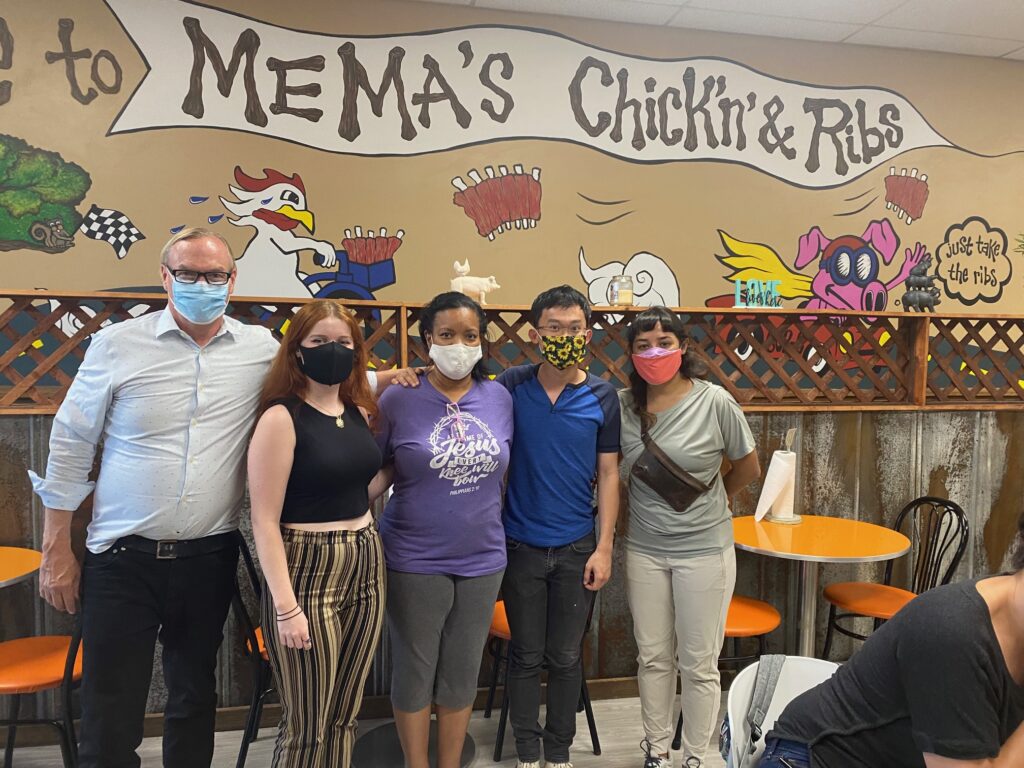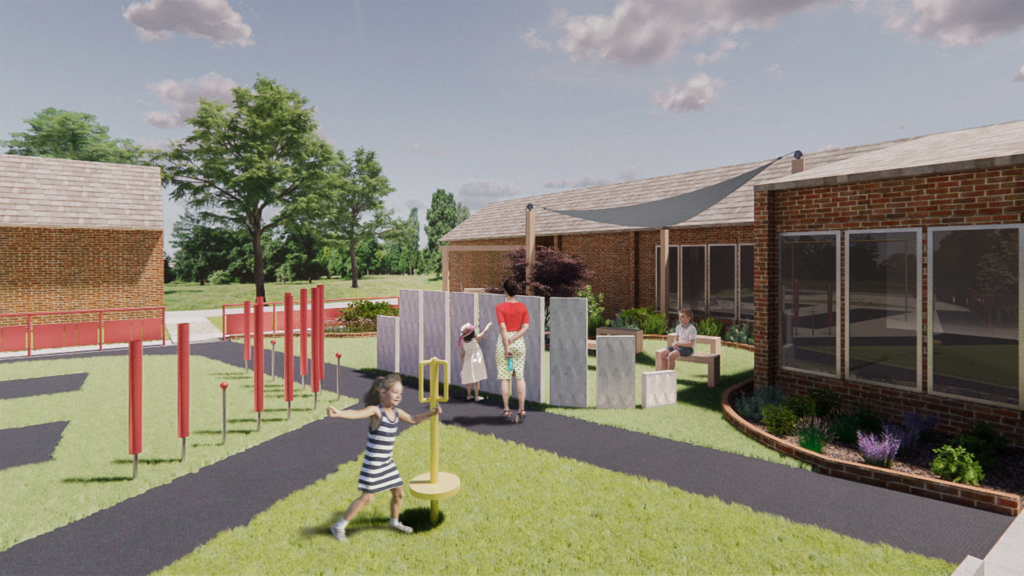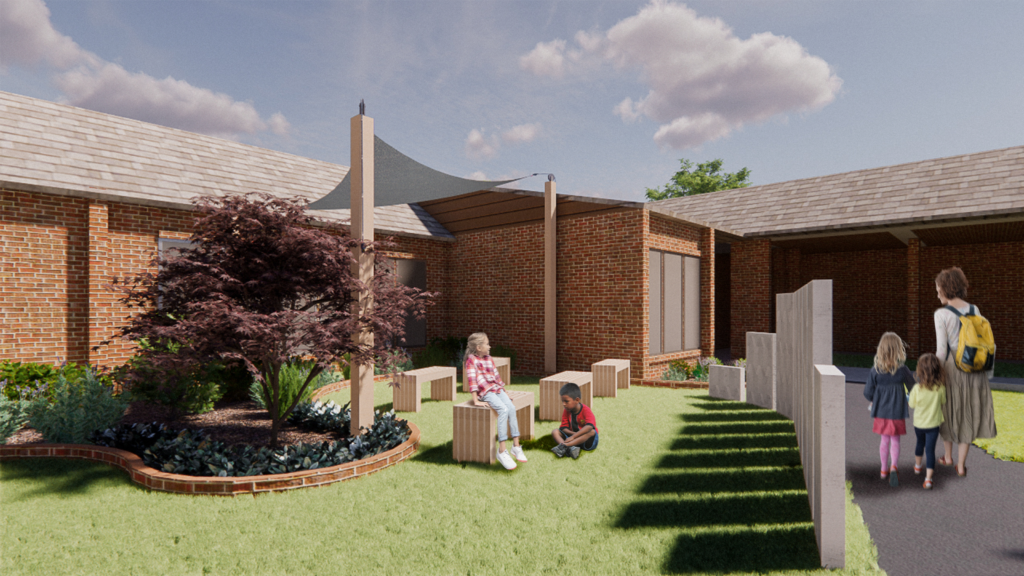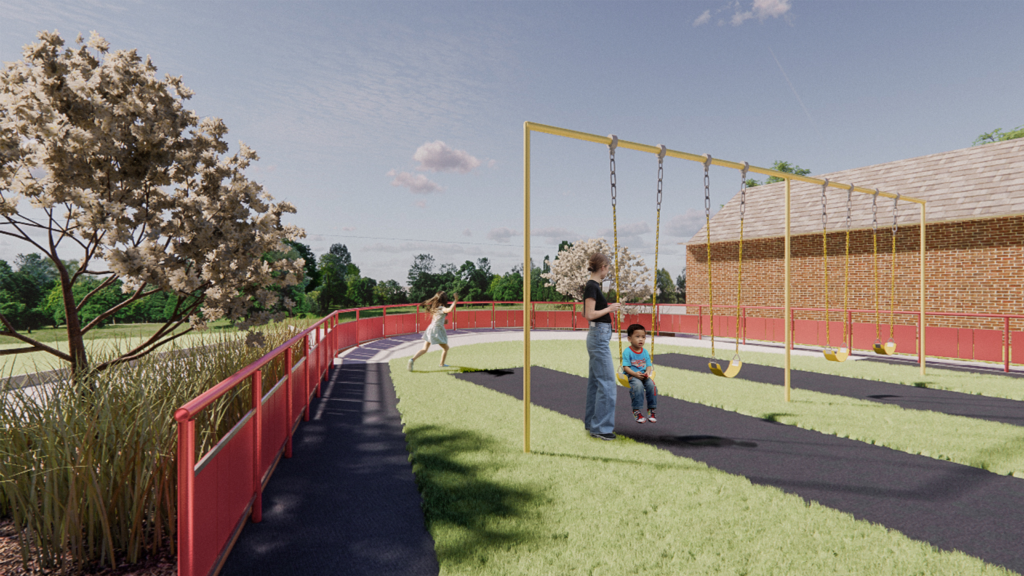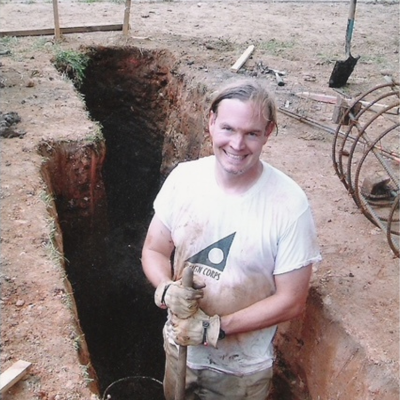
The goal of my work is to advance public access to the benefits of design.
Any impact of my work has made towards this goal has been through collaborative engagements with an ever-increasing group of stakeholders. This increase in stakeholders represent the adoption of public interest design by the greater public.
These collaborations provide the keys to understanding how the different perspectives might share their own interest in this goal. The more perspectives included in the goals of public interest design equal a greater public interest, greater adoption, and a greater public impact.
As a collective effort, I have worked with interested groups to formulate a set of tools that use a participatory process to work through these questions:
- What goals do we share?
- How can these shared goals strengthen each other?
- How can we use that strength to collectively make progress to provide for the complex, diverse, needs and cultural perspectives of the public – the public interest?
I have used each of the following tools to: (1) develop mutual understanding, (2) set a common goal, (3) increase the number of stakeholders of public interest design:
- Global networks
- National networks
- Publications
- International Conferences
- Awards Competitions
- Service
These tools are engagement-based collaborations at multiple scales and methods that reach diverse stakeholders. These tools clarify where there is a confluence of interests, essentially Venn diagram producers. These allow understanding to emerge for all collaborators, and from that understanding, successful practical applications emerge to achieve those results.
Here are some examples of my engagements using these tools:
From “Design for the Common Good Memorandum of Understanding.”
Design for the Common Good (DCG) aspires to be an incubator for best practices, education, training, and outreach in Public Interest Design (PID). In doing so we will strive together to grow the knowledge base and global capacity for the practice of PID.
Currently DCG is comprised of 5 organizations with members around the world: SEED Network, Pacific Rim Community Design Network, Live Projects Network, Design Build Xchange Europe and the Curry Stone Network. New member organizations may be added through unanimous agreement of the existing member organizations based on their finding that the new organization shares the vision, mission and core values of the organization.
Design for the Common Good strengthens the confluence of forces needed to create healthy, resilient and sustainable design projects that will further positive change in the world. Stronger together, we promote systemic change in the practices of design with the intent of building on the common ground we share. Through our work we promote collaboration and seek partnerships that further the growth of the network.
Each of the member organizations has unique characteristics, and individual projects within each member organization are diverse, but at a minimum the following general core values are shared:
- Enable future decision makers (e.g. students) to gain awareness for the relevance of their own work in the context of contributing towards a more socially, economically and ecologically sound environment.
- Generate ideas that grow from place and build local capacity
- Stimulate cooperation
- Share knowledge
- Advocate with those who have a limited voice in public life
- Build structures for inclusion that engage stakeholders and allow communities to make decisions
- Advance the right of every person to live in a socially, economically and environmentally healthy community
- Connect different actors working for the common good
- Promote social equality through discourse that reflects a range of values and social identities
- Recognize and respect the people and culture of each project place. We are grateful for their many contributions and honor their efforts to shape their own self-determined futures.
The near-term work is as follows:
- Promote peer to peer learning – enhance quick and effective sharing of best practices and problem areas
- Develop relationships between leaders of the five networks that are beneficial, both professionally and personally
- Work together to hold the Denver Structures for Inclusion International Conference, January 2022
- Work together, with funder Curry Stone Foundation and contractor Alternatives, to design the function, structure and operation of a website and platform that can grow organically through participation of the user base established by the five networks that focuses on education, engagement and interaction.
- Assess the resource needs (personnel and funding levels) for each network and the DCG to succeed and thrive and develop a fund-raising plan to support those needs
From team application to the National Endowment for the Arts (funded).
NOMA, NAACP and SEED Network are developing a process to explore, define and educate emerging design professionals, professionals, and community activists about Justice, Equity, Diversity and Inclusion in design.
NOMA, the National Association for the Advancement of Colored People Centering Equity in the Sustainable Building Sector Program, and the Social Economic Environmental Design Network are developing a set of criteria to educate/train emerging professionals, professionals, and community activists about Justice, Equity, Diversity and Inclusion (JEDI) in design, architecture, and land development in the US. The three organizations will collaborate to create case studies and to host a series of workshops, webinars, podcasts and a graphic poster series/publication highlighting projects that exemplify JEDI in Design. This work will be a framework for sustainability beyond green building geared toward African Americans.
The National Organization of Minority Architects (NOMA), the National Association for the Advancement of Colored People Centering Equity in the Sustainable Building Sector Program (NAACP-CESBS), and the Social Economic Environmental Design Network (SEED Network) are co-convening a process to define, demonstrate and then educate / train design emerging professionals, professionals, and community activists about Justice, Equity, Diversity and Inclusion (JEDI) in design, architecture, and land development in the US. The audience for this effort is primarily Black / African American and other people of color.
This two-year process began in Winter, 2020 with a survey of the members of each of the three partners. This survey is intended to begin a dialogue on the application of JEDI Principles in the design and construction of buildings, landscapes, and communities. The survey results were used as criteria for a national 2020 NOMA-NAACP-SEED Awards program that was juried by twelve nationally recognized activists, educators and practitioners of JEDI in design. This dialogue continued with the presentation and discussion of the seven award winners at the online NOMA National / Structures for Inclusion Conference on October 17th, 2020.
From Book Jacket, All-Inclusive Engagement in Architecture: Towards the Future of Social Change, by Farhana Ferdous and Bryan Bell.
Should all-inclusive engagement be the major task of architecture? All-Inclusive Engagement in Architecture: Towards the Future of Social Change presents the case that the answer is yes. Through original contributions and case studies, this volume shows that socially engaged architecture is both a theoretical construct and a professional practice navigating the global politics of poverty, charity, health, technology, neoliberal urbanism, and the discipline’s exclusionary basis. The scholarly ideas and design projects of 58 thought leaders demonstrate the architect’s role as a revolutionary social agent. Exemplary works are included from the United States, Mexico, Canada, Africa, Asia, and Europe. This book offers a comprehensive overview and in-depth analysis of all-inclusive engagement in public interest design for instructors, students, and professionals alike, showing how this approach to architecture can bring forth a radical reformation of the profession and its relationship to society.
My most recent research, with Dr. Farhana Ferdous, represent our collaborative effort with the 57 authors that we selected to include in 30 chapters of this publication. The submissions selected for chapters and case studies were both broad in diversity and deep in expertise. In other words, professional specializations are developing as evidence of growth of the field. Our five categories are:
- Inclusive Politics and Culture
- Pedagogical Engagement
- Scholarship of Engagement
- Practices and Tools of Contemporary Engagement
- Public Engagement and Public Health
These are not the only five, but these are a starting group of five. What these five have in common is engagement, but they are also diverse, suggesting the subject’s comprehensive span that could be covered in further research. Hence, we came up with the title “All-inclusive Engagement,” to accommodate the breadth and depth of the subject.
In finding this confluence of interests through these tools, we create collective action that can lead to change. These represent an alternative type of power to the current power structure that has long determined and shaped our built environment. As a collective action, these understandings of a common good create the focused energy of many, that is social capital as an alternative to traditional power structures. Like the Me-too Movement and Black Lives Matter, these empowerments not only grow outside of traditional systems, but they also challenge traditional systems. These are grassroots collective actions that challenge the orthodox systems of the status quo and allow equity in the decision-making process. These are examples of a future of social change.
Published Books – Peer Reviewed
Abendroth, L.M., and Bell, Bryan. Public Interest Design Practice Guidebook: SEED Methodology, Case Studies, and Critical Issues (New York: Routledge, Taylor & Francis Group, 2016).
Bell, Bryan, and Wakeford, Katie. Expanding Architecture: Design As Activism (New York: Metropolis Books, 2008).
Bell, Bryan. Good Deeds, Good Design: Community Service Through Architecture (New York: Princeton Architectural Press, 2004).
Published Chapters and Journal Articles – Peer Reviewed
Abendroth L.M., and Bell, Bryan. “Understanding Public Interest Design”, “Practicing Public Interest Design: SEED Methodology”, “Documenting the Value of Public Interest Design: Case Studies and Issues Index”, “The Issues Index: Expanded Opportunity through an Issues Approach”, “Case Studies and Issues Index”, “Issue Index Cross-Reference Guide”, “Locator Atlas”, in Public Interest Design Practice Guidebook: Seed Methodology, Case Studies and Critical Issues, (New York: Routledge, 2015).
Bell, Bryan, “The State of Public Interest Design,” in Public Interest Design Practice Guidebook: Seed Methodology, Case Studies and Critical Issues. (New York: Routledge, 2015).
Bell, Bryan. “Putting the Public in Public Interest Design.” Humanitarian Architecture: 15 stories of architects working after disaster, ed. Charlesworth, Esther (London: Routledge, 2014).
Bell, Bryan. “Public Interest Design” in The AIA Architects Handbook of Professional Practice, 15th Edition, (Hoboken, NJ: John Wiley & Sons, 2013).
Geier, Nathan; Lam, Sandy; and Cary, John. “Towards a Cultural Value of Design and Democracy” in Oz, University of Kansas Journal, Volume 25 (Manhattan, KS, New Prairie Press, 2013).
Gutman, Robert, Cuff, Dana, and Wriedt, J. “Pre-form and Post-form Design Activism” in Architecture from the Outside In (New York: Princeton Architectural Press, 2012).
Bell, Bryan. “Preface, Expanding Design towards Greater Relevance” in Expanding Architecture: Design as Activism (New York: Metropolis Books, 2008).
Bell, Bryan. “The Bat Signal: Exploring the Relationship between Justice and Design” Oz, the Journal of the College of Architecture, Planning and Design at Kansas State University. (Manhattan, KS, New Prairie Press, 2006).
Palleroni, Sergio and Merkelbach, Christina. “Introduction” Author. in Studio at large: Architecture in service of global communities. (Seattle: University of Washington Press 2004).
Grenader, Nonya, Scardino, Barrie, Bell, Bryan, “The 99K House and SEED” in 99K House Competition Publication. (Houston: Rice University Design Alliance, 2008).
Bell, Bryan, “Foreword: Designing for the 98% without Architects,” in Good Deeds, Good Design, Community Service through Architecture. (New York: Princeton Architectural Press, 2003).
Bell, Bryan, “Architecture as Artifact,” in Good Deeds, Good Design: Community Service through Architecture (New York: Princeton Architectural Press 2003).
Published Chapters and Journal Articles – Not Peer Reviewed
Bizios, Georgia and Wakeford, Katie. “Integrating Form and Content: Training Public Interest Interns.” in Bridging the Gap: Public-interest Architectural Internships. (Raleigh, NC: Lulu Press, 2011).
Feldman, Roberta, Bell, Bryan, Palleroni, Sergio and Perkes, David. “Wisdom from the Field: Public Interest Architecture in Practice” AIA On-line (February, 2013). https://network.aia.org/practicemanagement/blogs/seth-anderson/2017/07/17/aiapractice-
management-digest-july-2017
Bell, Bryan, “Designing for the 98% without Architects” in An Architektur Produktion und Gebrauch gebauter Umwelt (March 2005).
Bell, Bryan, Essay in Out of the Box Exhibit Publication. (Chicago, Field Museum: UIC, 2005).
Chapters by Others About/Referencing Bell’s Work – Peer Reviewed
Hammett, Jerilou & Wrigley, Maggie. “Self Help Housing.” The architecture of change: Building a better world. (Albuquerque, NM: University of New Mexico Press. 2013).
Cary, John. The Power of Pro Bono: 40 Stories About Design for the Public Good by Architects and Their Clients (New York: Distributed Art, 2011).
Moore, Steven A. and Brown, Barbara Wilson. Questioning Architectural Judgement the Problem of Codes in the United States. (Oxon, UK: Routledge, 2007).
Jacobs, Karrie. The Perfect $100,000 House: A Trip Across America and Back in Pursuit of a Place to Call Home (New York: Penguin Books, 2006).
Lepik, Andres. Small Scale, Big Change: New architectures of social engagement: Exhibition, Museum of modern art, New York, October 3, 2010-January 3, 2011. (New York: Museum of Modern Art, 2010).
Sinclair, Cameron. Design Like You Give a Damn (New York, NY: Abrams, 2006).
Journal Articles by Others About/Referencing Bell’s Work – Peer Reviewed
Shall, Scott. “Book Review of Design like You Give a Damn: Architectural Responses to Humanitarian Crises – Architecture for Humanity and Expanding Architecture: Design as Activism – Edited by Bryan Bell and Katie Wakeford,” Journal of Architectural Education, Volume 62:4, 132-134.
Lupton, Ellen, Albrecht, Donald, Yelavich, Susan, Mitchell, Owens. Inside Design Now, Smithsonian Design Triennial. Cooper Hewitt National Design Museum (New York: Princeton Architectural Press, 2003).
Published Books – Peer Reviewed
Abendroth, L.M., and Bell, Bryan. Public Interest Design Education Guidebook: Curricula, Strategies, and SEED Academic Case Studies (New York: Routledge, Anticipated 10/2018).
Ferdous, F. and Bell, Bryan. All In: All Inclusive Engagement in Architecture
Published Chapters and Journal Articles – Peer Reviewed
Abendroth L.M., and Bell, Bryan. “Introduction”, “The SEED Process for Academia”, “SEED Academic Case Studies”, “Learning Objective Index”, “Program Consideration Index.” in Public Interest Design Education Guidebook: Curricula, Strategies, and SEED Academic Case Studies (New York: Routledge, Anticipated 10/2018).
Abrams, Robin, Bressler, G., Bell, Bryan, “A Comprehensive Public Interest Design Curriculum: College of Design, North Carolina State University.” in Public Interest Design Education Guidebook: Curricula, Strategies, and SEED Academic Case Studies (New York: Routledge, Anticipated 10/2018).
Arcury, Thomas A., Bell, Bryan, Gabbard, Susan. Casanova V., Flocks, Joan D., Swanberg, Jennifer E, Wiggins, Melinda F. “Collecting Comparative Data on Farmworker Housing and Health: Recommendations for Collecting Housing and Health Data across Places and Time.” New Solutions: A Journal of Environmental and Occupational Health Policy, 2015.
Published Chapters and Journal Articles – Not Peer Reviewed
Bell, Bryan. “The Avant Garde, Renewing a Concept and Renewing a Role,” in Flux, the Student Publication of NCSU College of Design, by Pelfrey, Ashley & Smith, Rachel, 2017.
Journal Articles by Others About/Referencing Bell’s Work – Peer Reviewed
Moore, Steven A. “Knowledge, Education, Power and Production: Public Interest Design in North America,” Journal of Architectural Education, 2017 71(1), 46-55.
Public Interest Design Institutes: 2012 – 2015, Twenty-eight two-day sessions organized with professional associations, community partners and university partners as hosts.
Principal Investigator, Public Interest Design Institute, Hosted by École Spéciale d’Architecture, Paris, France, Funded by Fetzer Institute (Cross listed in grants section)
Principal Investigator Public Interest Design Institute, Host: National Autonomous University of Mexico, Mexico City, Mexico, Funded by Fetzer Institute (Cross listed in grants section)
Co-organizer, Public Interest Design Institute, hosted by Design Corps, the SEED Network, The College of Architecture and the Built Environment and the Lab for Urban and Social Innovation at Jefferson and Philadelphia University, 10/13-14/2017. Speakers: Kim Douglas, Sarah Endriss, Deborah Gans, Keir Johnston, Beth Miller, Philip Szostak. Susan Thering, Howard Ways, III.
Co-organizer, Public Interest Design Institute, hosted by Design Corps, the SEED Network, the Sam Fox School of Design and Visual Arts at Washington University in St. Louis, 10/6-7/2017. Speakers: Pacia Anderson, Rod Barnett, Mark Cross, John Cruz, Amanda Colon-Smith, Joel Fuoss, Jeremy Knoll, Elaine Moralez, Esther Shin, Susan Thering, Rebecca Weaver and Steve Zwolak.
Co-organizer, Public Interest Design Institute, hosted by Design Corps, the SEED Network, and the New Orleans AIA, 9/29-30/2017. Speakers: William Bradshaw, Nick Jenisch, Jeremy Knoll, Greg Kearley, Wes Michaels, Sue Mobley, Andreanecia M. Morris, Jenga Mwendo, Paula Peer, David Perkes, Joel Pominville, Amanda Rivera, Susan Thering.
Co-organizer, Public Interest Design Institute, hosted by Design Corps, The Shade Institute, and the East-West Center, 7/2017. Speakers: Susie Chun Oakland, Jeffrey Hou, Harrison Rue, Dean Sakamoto, Mary Pat Waterhouse, Susan Thering.
Co-organizer, Public Interest Design Institute, hosted by AIA Portland and Portland State University, Portland, OR, 3/24-25/2017, Speakers: Bryan Bell, Jane Anderson, Peter Fattinger, Ursula Hartig, Matthew Jelacic, DK Osseo-Asare, Sergio Palleroni, Nina Pawlicki, Bryan Pittman, Susan Thering
Co-organizer, Public Interest Design Institute, hosted by AIA National Office and Catholic University, Washington, DC, 3/24-25/2017, Speakers: Bryan Bell, Carlton Eley, Bradley Guy, Greg Kearley, Sheila Lewis, Nadine Maleh, Joel Mills,
Rachel Minnery, Rayya Newman, Suman Sorg, Stefan Schwarzkopf, Philip Szostak, Susan Thering, Chapman Todd
External Advisory Group: Association of Architectural Educators Sesquiannual International Conference, “Connected: pedagogical strategies for design that engage Academia and Society.” Submitted by Oxford Brookes School of Architecture, Oxford Brookes University, 2017
Co-organizer, Public Interest Design Institute, hosted by Design Corps, SEED Network, building communityWORKSHOP, University of North Texas, University of Texas Arlington, and AIA Dallas, in Dallas, Texas 9/25-26, 2015.Speakers: Bryan Bell, Catherine Baker, Greta Buehrie, Ingrid Haftel, Andy Moon, Bill Hall, Brian Keith, Laura Eder, Jonathan Rollins, Michael Westfall, Grady (Buddy) Jordan, Jr., Pat Bywaters, Daron Babcock

Dallas Foundation commitment to Design Corps, General Support, $50,000/year for five years, $250,000, 2016-2021
NEA Structures for Inclusion Conference, $43,250 – Pending
NC State Freedom by Design, NCARB grant, $7,500, 2017
NEA, with Fran Abrams, Artworks Program: To fund research on Triangle Modernism, $70,625, 2016 – Unsuccessful
NEA Public Interest Design Education Guidebook, $51,500, 2016 – Unsuccessful
National Endowment for the Arts, Art Works Program, Design Corps, 2013, $40,000. To support “Structures for Inclusion,” a national conference on public service architecture and community design that will bring together designers, nonprofit leaders, academics, and students to discuss the role of social impact design and will feature innovative design projects that address the needs of underserved populations.
National Endowment for the Arts, Art Works Program, Design Corps, 2012, $40,000, To support training in community-driven design through the Public Interest Design Institute’s Social Economic Environmental Design process.
National Endowment for the Arts, Art Works Program, Design Corps, 2010, $25,000. To support the Hollygrove Design Initiative, in consortium with the AARP Foundation’s Livable Communities Initiative pilot project in the Hollygrove neighborhood in New Orleans.
National Endowment for the Arts, Art Works Program, Design Corps, 2009, $17,000. To support the Structures for Inclusion X conference, in consortium with Howard University in Washington, DC.
National Endowment for the Arts, Access to Artistic Excellence Program, Design Corps, 2005. $35,000, To support the development of architectural designs for the rural community of Seaboard, North Carolina. Results of the project will be disseminated by a national publication.
National Endowment for the Arts, Access to Artistic Excellence Program, Design Corps, 2003. $35,000, To support conferences and a publication focused on providing quality design services to those not traditionally served by architects.
National Endowment for the Arts, Access to Artistic Excellence Program, Design Corps, 2003. $40,000, To support the completion of a community-based design project for a job training and day care center in Perry County, Alabama.
National Endowment for the Arts, Access to Artistic Excellence Program, Design Corps, 2002. $34,000, To support conferences and a publication that focus on providing quality design services to those not traditionally served by architects.
Driehaus Foundation, $60,000, Design Corps. To fund the Public Interest Design Institute program, 2012
Surdna Foundation, Design Corps, Thriving Cultures Program, 2011 – 2013, $240,000
FAIA Latrobe Research Prize, Feldman, Palleroni, Perkes and Bell, 2010-11, $100,000
Fetzer Institute, Contract Funding for PID Institutes for Paris and Mexico City and Film Documentaries by Vid Tiger
Graham Foundation for the Advancement of the Fine Arts, 2 times
US Department of Housing and Urban Development, 3 times
USDA 523 Mutual Self Help Housing Program, Initiated Self-Help Homeownership Program, Individualized designs for self-construction by twelve families in Adams County, PA
Florida Modular “on-frame modular” Housing with Florida Migrant Legal Services, $10,000 2006
Enterprise Foundation Rose Fellowship — Host, Marion Child Care and Job Training Center, $120,000
Migrant Community Garden and Market with Wake Forrest School of Public Health and Episcopal Farmworker Ministries and funded by the US Department of Agriculture, 9/2005-10
USDA RD 523 Mutual Self Help Program, Self-Help Home-ownership Program, Adams County, PA, $300,000, 2002 (Cross listed in collaboration section) Foundation of Western North Carolina, 7-8/2005 & 7-8/2006, $20,000
Federal, State and County sources including LIHTC, Historic Tax Credits, HUD HOME and PA Department of Community Affairs, Row-houses, Gettysburg, PA, 1992-1994
Federal, State and County sources including LIHTC, HUD HOME and PA Department of Community Affairs, Rural Opportunities Inc., Twelve affordable houses for ownership, 1991-1993
PA Department of Community Affairs, Rural Opportunities Inc., Migrant Housing Units, 1991-1993
American Institute of Architecture and American Architecture Foundation, University of Pennsylvania, Scholarship for Post-graduate Advanced Research, $2,500, 1990
Provost’s Office, Course Innovation Funds. $8,000. To create twelve documentary interviews of architects currently practicing in Triangle area for Triangle Modern Architecture course. 2016
Delta Grant: 2016, $8,000 – Unsuccessful. To initiate a distance education course in the rapidly emerging field of Public Interest Design. This research-based content educates students and professionals in how to use design to address the most critical challenges communities face in the world. This is an opportunity to further align the teaching, research and outreach of the School of Architecture with the mission of the University and the strategic plan of the College of Design. This course would capitalize on NCSU’s past leadership and current faculty, as well as join the growing cultural momentum to provide professional public service.

